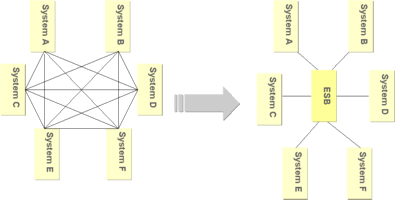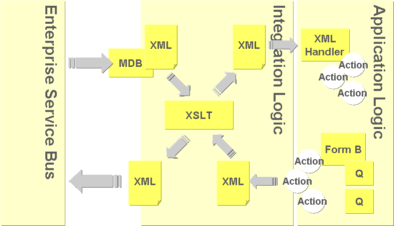| Enterprise Service Bus |
| |
|
System integration is a complex process where a number of points are important. Most important points of interest are:
|
- several applications have several communication protocols
- several applications have different information needs
- communication between different applications frequently produces non maintainable connections
- introducing dependences between applications strongly raises complexity
- the maintainability decreases exponentially
|
| |
|
The above problems are addressed by the use of the Enterprise Service Bus (ESB). ESB is an integration platform based on industry standards. This platform combines asynchronous message communication, Web Services, date transformation and intelligent routing. Moreover the ESB supports a large number of other communication protocols with adapters.
|
| |
 |
| |
|
THE ESB offers a number of large advantages regarding solving integration issues:
|
- Separation of systems; all systems couple with the ESB instead of with each other
- The ESB supports several communication protocols with adapters
- The ESB is able to make translations between communication protocols
- Synchronous and asynchronous communication is possible
- Routing on the basis of contents
- Transformations
- The ESB centralizes integration issues
- Improves the control of the system architecture
|
| |
|
The ePlatform framework offers generic components with which it is possible to communicate with the ESB by using the Java Message Service (JMS). JMS is a standard J2EE API for sending and receiving messages. By using JMS both the architecture and the interfacing to other systems become loosely-coupled. All this reduces dependences between systems and increases control and reliability.
|
| |
 |
| |
|
The communication between ePlatform framework and the Enterprise Service Bus is done by the exchange of XML. XSL transformation is used to format the internal XML to that used in the message definition.
|
| |
|
A Distincion is made between incoming and outgoing messages. For an outgoing message the XSL stylesheet is configurable within the Action object. The Generic Message Driven Bean (MDB) is responsible for incoming messages. The MDB stylesheet is configured by message type. Different message types determine which stylesheet is used for translating the message to the internal XML structure. This internal format can be used to carry out actions in the XML handler.
|
| |
| Back to integration |



